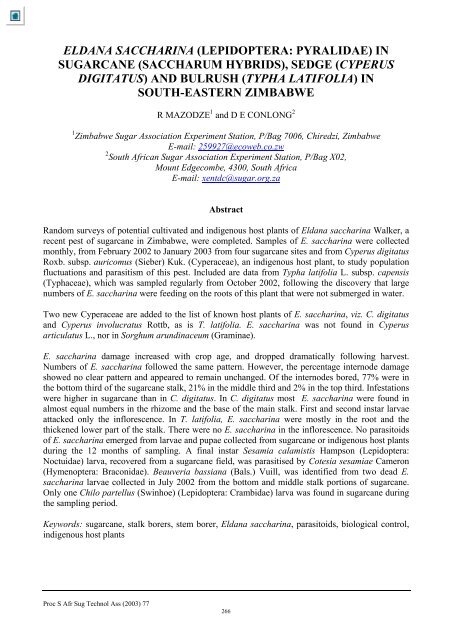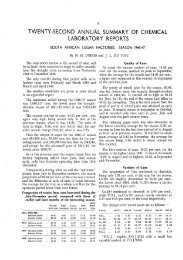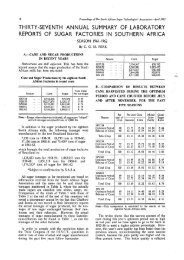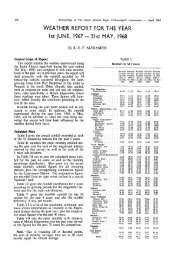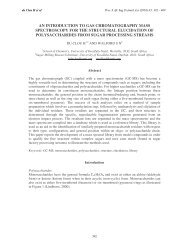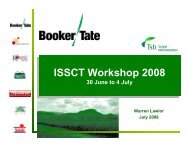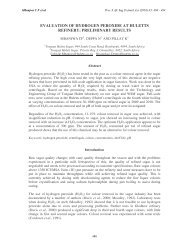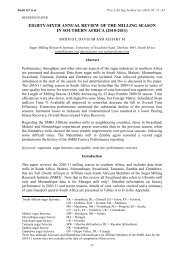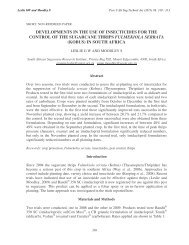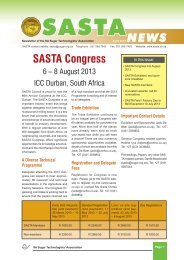Eldana Saccharina (Lepidoptera: Pyralidae) in Sugarcane ... - sasta
Eldana Saccharina (Lepidoptera: Pyralidae) in Sugarcane ... - sasta
Eldana Saccharina (Lepidoptera: Pyralidae) in Sugarcane ... - sasta
Create successful ePaper yourself
Turn your PDF publications into a flip-book with our unique Google optimized e-Paper software.
ELDANA SACCHARINA (LEPIDOPTERA: PYRALIDAE) IN<br />
SUGARCANE (SACCHARUM HYBRIDS), SEDGE (CYPERUS<br />
DIGITATUS) AND BULRUSH (TYPHA LATIFOLIA) IN<br />
SOUTH-EASTERN ZIMBABWE<br />
R MAZODZE 1 and D E CONLONG 2<br />
1 Zimbabwe Sugar Association Experiment Station, P/Bag 7006, Chiredzi, Zimbabwe<br />
E-mail: 259927@ecoweb.co.zw<br />
2 South African Sugar Association Experiment Station, P/Bag X02,<br />
Mount Edgecombe, 4300, South Africa<br />
E-mail: xentdc@sugar.org.za<br />
Abstract<br />
Random surveys of potential cultivated and <strong>in</strong>digenous host plants of <strong>Eldana</strong> sacchar<strong>in</strong>a Walker, a<br />
recent pest of sugarcane <strong>in</strong> Zimbabwe, were completed. Samples of E. sacchar<strong>in</strong>a were collected<br />
monthly, from February 2002 to January 2003 from four sugarcane sites and from Cyperus digitatus<br />
Roxb. subsp. auricomus (Sieber) Kuk. (Cyperaceae), an <strong>in</strong>digenous host plant, to study population<br />
fluctuations and parasitism of this pest. Included are data from Typha latifolia L. subsp. capensis<br />
(Typhaceae), which was sampled regularly from October 2002, follow<strong>in</strong>g the discovery that large<br />
numbers of E. sacchar<strong>in</strong>a were feed<strong>in</strong>g on the roots of this plant that were not submerged <strong>in</strong> water.<br />
Two new Cyperaceae are added to the list of known host plants of E. sacchar<strong>in</strong>a, viz. C. digitatus<br />
and Cyperus <strong>in</strong>volucratus Rottb, as is T. latifolia. E. sacchar<strong>in</strong>a was not found <strong>in</strong> Cyperus<br />
articulatus L., nor <strong>in</strong> Sorghum arund<strong>in</strong>aceum (Gram<strong>in</strong>ae).<br />
E. sacchar<strong>in</strong>a damage <strong>in</strong>creased with crop age, and dropped dramatically follow<strong>in</strong>g harvest.<br />
Numbers of E. sacchar<strong>in</strong>a followed the same pattern. However, the percentage <strong>in</strong>ternode damage<br />
showed no clear pattern and appeared to rema<strong>in</strong> unchanged. Of the <strong>in</strong>ternodes bored, 77% were <strong>in</strong><br />
the bottom third of the sugarcane stalk, 21% <strong>in</strong> the middle third and 2% <strong>in</strong> the top third. Infestations<br />
were higher <strong>in</strong> sugarcane than <strong>in</strong> C. digitatus. In C. digitatus most E. sacchar<strong>in</strong>a were found <strong>in</strong><br />
almost equal numbers <strong>in</strong> the rhizome and the base of the ma<strong>in</strong> stalk. First and second <strong>in</strong>star larvae<br />
attacked only the <strong>in</strong>florescence. In T. latifolia, E. sacchar<strong>in</strong>a were mostly <strong>in</strong> the root and the<br />
thickened lower part of the stalk. There were no E. sacchar<strong>in</strong>a <strong>in</strong> the <strong>in</strong>florescence. No parasitoids<br />
of E. sacchar<strong>in</strong>a emerged from larvae and pupae collected from sugarcane or <strong>in</strong>digenous host plants<br />
dur<strong>in</strong>g the 12 months of sampl<strong>in</strong>g. A f<strong>in</strong>al <strong>in</strong>star Sesamia calamistis Hampson (<strong>Lepidoptera</strong>:<br />
Noctuidae) larva, recovered from a sugarcane field, was parasitised by Cotesia sesamiae Cameron<br />
(Hymenoptera: Braconidae). Beauveria bassiana (Bals.) Vuill, was identified from two dead E.<br />
sacchar<strong>in</strong>a larvae collected <strong>in</strong> July 2002 from the bottom and middle stalk portions of sugarcane.<br />
Only one Chilo partellus (Sw<strong>in</strong>hoe) (<strong>Lepidoptera</strong>: Crambidae) larva was found <strong>in</strong> sugarcane dur<strong>in</strong>g<br />
the sampl<strong>in</strong>g period.<br />
Keywords: sugarcane, stalk borers, stem borer, <strong>Eldana</strong> sacchar<strong>in</strong>a, parasitoids, biological control,<br />
<strong>in</strong>digenous host plants<br />
Proc S Afr Sug Technol Ass (2003) 77
Introduction<br />
The African sugarcane stalk borer, <strong>Eldana</strong> sacchar<strong>in</strong>a Walker (<strong>Lepidoptera</strong>: <strong>Pyralidae</strong>) was first<br />
recorded as a pest of sugarcane <strong>in</strong> Zimbabwe <strong>in</strong> March 1999, when a severe outbreak occurred <strong>in</strong><br />
two adjacent fields at Triangle Estate (Mazodze et al., 1999). In other parts of Africa, this<br />
<strong>in</strong>digenous <strong>in</strong>sect is a long-established and serious pest of sugarcane and, to a lesser extent, maize<br />
and sorghum (Girl<strong>in</strong>g, 1972; Waiyaki, 1974; Atk<strong>in</strong>son, 1979, 1980). A survey carried out <strong>in</strong><br />
sugarcane and sedges (Cyperus spp.) <strong>in</strong> May 1987 by two entomologists from the South African<br />
Sugar Association Experiment Station (Dr AJM Carnegie and Mr GW Leslie) revealed that<br />
sugarcane <strong>in</strong> Zimbabwe was not be<strong>in</strong>g attacked by E. sacchar<strong>in</strong>a at that time. However, a few<br />
larvae were found <strong>in</strong> a sedge, Cyperus digitatus Roxb. subsp. auricomus (Sieber) Kuk.<br />
(Cyperaceae), at Christ<strong>in</strong>e Dam on Triangle Estate (Anon, 1988). E. sacchar<strong>in</strong>a is therefore<br />
regarded as a recent pest of sugarcane <strong>in</strong> Zimbabwe, and there is little <strong>in</strong>formation on its biology<br />
and ecology under local conditions.<br />
Surveys completed <strong>in</strong> Zimbabwean commercial sugarcane s<strong>in</strong>ce the outbreak of E. sacchar<strong>in</strong>a <strong>in</strong><br />
1999 showed that the borer is now widespread throughout the <strong>in</strong>dustry (Anon, 2001, 2002, 2003).<br />
Estimated losses <strong>in</strong> recoverable sugar of 0.9% were recorded for 2000 and 2001 and 1% for 2002<br />
(Anon, 2001, 2002, 2003). E. sacchar<strong>in</strong>a is currently regarded as the most serious pest of sugarcane<br />
<strong>in</strong> Zimbabwe. This study reports the results of random surveys undertaken to identify <strong>in</strong>digenous<br />
host plants of E. sacchar<strong>in</strong>a <strong>in</strong> the area, to monitor changes <strong>in</strong> populations of the pest and to<br />
determ<strong>in</strong>e levels of parasitism at selected sites.<br />
Predators of this borer <strong>in</strong> South Africa were <strong>in</strong>vestigated thoroughly by Leslie (1981), when ants<br />
(Formicidae), spiders (Arachnidae), cochroaches (Blattidae) and earwigs (Dermaptera) were<br />
frequently found <strong>in</strong> empty tunnels made by the borer <strong>in</strong> sugarcane stalks. In the southern African<br />
region, much effort was focused on the biological control of E. sacchar<strong>in</strong>a us<strong>in</strong>g parasitoids<br />
(Conlong and Hast<strong>in</strong>gs, 1984; Carnegie et al., 1985; Conlong et al., 1988; Conlong, 1990). Two<br />
parasitoids of E. sacchar<strong>in</strong>a were recorded <strong>in</strong> Zimbabwe <strong>in</strong> 1999, one an unidentified ichneumonid<br />
recovered from C. digitatus at Section 4, Hippo Valley Estate, and the other an unidentified<br />
braconid wasp recovered from young sugarcane at Section 6, Triangle Estate (Anon, 2001). In the<br />
latter recovery, the borer may have been misidentified, and could possibly have been Sesamia<br />
calamistis Hampson (<strong>Lepidoptera</strong>: Noctuidae). It is hoped that parasitoids from an <strong>in</strong>digenous host<br />
plant will be effective <strong>in</strong> sugarcane <strong>in</strong> some form of ‘modified’ classical biological control, as<br />
argued by Conlong (1990), and this study therefore <strong>in</strong>cluded two <strong>in</strong>digenous host plants <strong>in</strong> regular<br />
surveys <strong>in</strong> the search for parasitoids. In South Africa, more parasitoids have been found <strong>in</strong><br />
<strong>in</strong>digenous host plants than <strong>in</strong> sugarcane (Conlong, 1990; Waage and Hassel, 1982; Cock, 1986).<br />
This stresses the importance of gather<strong>in</strong>g sound <strong>in</strong>formation about the <strong>in</strong>sect’s ecology if successful<br />
biological control programmes are to be developed.<br />
Materials and Methods<br />
Indigenous host plants<br />
Random surveys were done <strong>in</strong> mid-June 2002 to identify <strong>in</strong>digenous host plants of E. sacchar<strong>in</strong>a.<br />
Searches were concentrated ma<strong>in</strong>ly on sedges, large grasses, and bulrush <strong>in</strong> areas surround<strong>in</strong>g<br />
sugarcane fields, particularly along rivers, streams, dra<strong>in</strong>age l<strong>in</strong>es and around dams. E. sacchar<strong>in</strong>a<br />
was expected to be present <strong>in</strong> the larval and/or pupal stages dur<strong>in</strong>g this period (Anon, 2001, 2002,<br />
2003). At each randomly selected site, about 200 plants of each species were uprooted and each<br />
whole plant <strong>in</strong>spected for E. sacchar<strong>in</strong>a damage. Larvae and pupae found were recorded, as were<br />
other borer species recovered.
Live E. sacchar<strong>in</strong>a (larvae and pupae) were collected <strong>in</strong> 30 ml plastic vials conta<strong>in</strong><strong>in</strong>g laboratoryprepared<br />
diet medium (Graham and Conlong, 1988), to check for parasitism. Dead borers were<br />
collected <strong>in</strong> empty vials and monitored for the emergence of pathogens or parasitoids.<br />
E. sacchar<strong>in</strong>a <strong>in</strong>festations and parasitoids <strong>in</strong> sugarcane, sedges and bulrush<br />
From February 2002 to January 2003, E. sacchar<strong>in</strong>a was sampled monthly, from four sugarcane<br />
fields, three on Section 7, Triangle Estate, <strong>in</strong> early, mid and late cut sugarcane of variety NCo376<br />
(fields 242, 250 and 269 respectively), and one mid cut field of sugarcane variety N14, on Section<br />
4, Hippo Valley Estate (field 458), and also from one site of C. digitatus on Hippo Valley Dam 4<br />
(close to field 458). A T. latifolia site at Nhoro Dam, Section 12, Hippo Valley Estate, was sampled<br />
regularly from October 2002.<br />
<strong>Sugarcane</strong><br />
In sugarcane, the same section of field (about 3 hectares) was sampled once per month to obta<strong>in</strong> a<br />
200 stalk sample. Stalks were sampled at random by pac<strong>in</strong>g every 10th row, remov<strong>in</strong>g the first<br />
sample stalk from the edge of the field and thereafter one stalk every 10 paces, to the end of the<br />
row. Ten random stalks were sampled from each of 20 rows paced. The first row sampled was<br />
either close to bush/wetland or another sugarcane field. Similarly, the first stalk per row was either<br />
from the field edge close to another sugarcane field or close to bush/wetland, so that if a parasitoid<br />
was recovered from cane close to bush/wetland, and the same species of parasitoid was not found<br />
further <strong>in</strong>to the field, it could be <strong>in</strong>ferred that it orig<strong>in</strong>ated from that bush/wetland. The number of<br />
<strong>in</strong>ternodes on each stalk was counted, and the stalk was then split longitud<strong>in</strong>ally. Each stalk was<br />
then divided <strong>in</strong>to thirds, giv<strong>in</strong>g the bottom, mid and top portions each an equal numbers of<br />
<strong>in</strong>ternodes. Before the stalk was dissected, any pupae <strong>in</strong> the leaf sheaths on the outside of the stalk<br />
were collected and their position on the stalk recorded. Pupae were placed <strong>in</strong>to empty 30 ml plastic<br />
vials (one pupa per vial), and each larva was similarly placed <strong>in</strong>to a vial conta<strong>in</strong><strong>in</strong>g laboratory<br />
prepared diet medium. Eggs were not sampled s<strong>in</strong>ce these are very difficult to f<strong>in</strong>d under field<br />
conditions (Waiyaki, 1974; Atk<strong>in</strong>son, 1980; Carnegie and Smaill, 1982). The vials were then<br />
labeled, giv<strong>in</strong>g details of date, field number and sample number. Separate records were also made<br />
of sample number, date, field number, position on the plant, and <strong>in</strong>star stage (‘1-6’ for larvae and<br />
‘P’ for pupae). Dead larvae were collected <strong>in</strong> empty numbered 30 ml plastic vials. Larvae were<br />
categorised as small (first and second <strong>in</strong>stars), medium (third and fourth <strong>in</strong>stars) or large (fifth and<br />
sixth <strong>in</strong>stars). The sampl<strong>in</strong>g procedures used were similar to those described by Conlong (1990) and<br />
Conlong and Mugalula (2001).<br />
All live and dead E. sacchar<strong>in</strong>a samples were sent to the South African Agricultural Research<br />
Council’s Plant Protection Research Institute (ARC-PPRI) quarant<strong>in</strong>e laboratory <strong>in</strong> Pretoria for<br />
authoritative identification of any parasitoids that emerged. Should a parasitoid emerge, the vial<br />
number could be cross-referenced with the field records to obta<strong>in</strong> more <strong>in</strong>formation about its host,<br />
e.g. <strong>in</strong>star stage, the portion of the stalk from which the host was recovered, and also whether the<br />
stalk was taken from the field edge close to bush/wetland or close to another sugarcane field.<br />
Indigenous host plants<br />
For sedges and bulrush, a stratified random sampl<strong>in</strong>g method was used, and 200 plants were<br />
<strong>in</strong>spected each month. The area of sedges or bulrush was divided <strong>in</strong>to three strips (strata), so that<br />
stratum 1 was closest to the sugarcane field and stratum 3 furthest away. For bulrush, where there<br />
was no adjacent sugarcane, stratum 1 was closest to the dam water and stratum 3 furthest away.<br />
About 66 plants were uprooted at random from each of the three strata.
For sedges, the plants were divided <strong>in</strong>to rhizome (R) (represent<strong>in</strong>g the true stem), stalk (S)<br />
(represent<strong>in</strong>g the true leaf) and flower base (F), whereas for bulrush they were divided <strong>in</strong>to root<br />
(<strong>in</strong>clud<strong>in</strong>g thickened basal part of stem), rest of stem and <strong>in</strong>florescence. Larvae and pupae found<br />
were counted, collected <strong>in</strong>to vials and recorded as described for sugarcane. Samples were sent to the<br />
ARC-PPRI quarant<strong>in</strong>e laboratory <strong>in</strong> Pretoria for authoritative identification of parasitoids.<br />
Statistical analyses<br />
E. sacchar<strong>in</strong>a <strong>in</strong>festations <strong>in</strong> the host plants were expressed as number of E. sacchar<strong>in</strong>a per 100<br />
plants. One-way Analysis of Variance (ANOVA) was used to compare numbers of E. sacchar<strong>in</strong>a<br />
from different parts of the plant us<strong>in</strong>g MSTAT.<br />
Results and Discussion<br />
Indigenous host plants of E. sacchar<strong>in</strong>a<br />
Table 1 lists the <strong>in</strong>digenous plant species randomly sampled for the presence of E. sacchar<strong>in</strong>a and<br />
other borers (n = 200 per site). The sedge, C. digitatus, was the only known local <strong>in</strong>digenous host<br />
plant of E. sacchar<strong>in</strong>a <strong>in</strong> Zimbabwe, although this <strong>in</strong>formation was not formally published. Two<br />
more <strong>in</strong>digenous wild host plants of E. sacchar<strong>in</strong>a, viz. bulrush, Typha latifolia L. subsp. capensis<br />
(Rohrb.) N. E. Br. (Typhaceae), and Cyperus <strong>in</strong>volucratus Rottb. (Cyperacaeae) are now added to<br />
the list of host plants of E. sacchar<strong>in</strong>a <strong>in</strong> Zimbabwe. Relative to other borers, large numbers of E.<br />
sacchar<strong>in</strong>a were found <strong>in</strong> T. latifolia, particularly where the bases of the plants were not submerged<br />
<strong>in</strong> water. This is the first report of E. sacchar<strong>in</strong>a feed<strong>in</strong>g on a member of the family Typhaceae. In<br />
South Africa, Atk<strong>in</strong>son (1980) found species of Typhaceae to be non-hosts. No E. sacchar<strong>in</strong>a were<br />
found <strong>in</strong>fest<strong>in</strong>g Cyperus articulatus L. (Cyperaceae) and wild sorghum, Sorghum arund<strong>in</strong>aceum<br />
(Desv.) Stapf. (Poacaeae), although the latter has been recorded as a host <strong>in</strong> east and west Africa<br />
(Girl<strong>in</strong>g, 1972). In the Cyperaceae, the borer attacked the rhizome, the stalk base and the basal parts<br />
of the <strong>in</strong>florescence, the latter be<strong>in</strong>g associated more frequently with first and second <strong>in</strong>star larvae.<br />
In T. latifolia, E. sacchar<strong>in</strong>a occurred <strong>in</strong> the root and thickened part of the stalk, and a little above it<br />
on the ma<strong>in</strong> stalk, and no borer was found <strong>in</strong> the <strong>in</strong>florescence.<br />
Table 1. Number of sites sampled, mean numbers of borers per 100 plants and percentage<br />
plants damaged from list of <strong>in</strong>digenous plants occurr<strong>in</strong>g mostly <strong>in</strong> wetland areas around<br />
sugarcane fields <strong>in</strong> the south-east Lowveld of Zimbabwe that were randomly sampled for<br />
the presence of borers <strong>in</strong> mid-June 2002 (n=200). (Plant species were identified by plant<br />
biosystematists based at the Harare Botanic Gardens, Zimbabwe.)<br />
Common name<br />
of plant<br />
Botanical name<br />
Number of<br />
sites<br />
sampled<br />
<strong>Eldana</strong><br />
per 100<br />
plants<br />
Chilo<br />
per 100<br />
plants<br />
Sesamia<br />
per 100<br />
plants<br />
% plants<br />
bored (all<br />
borers)<br />
Wild Sorghum<br />
Sedge<br />
Sedge<br />
Sedge<br />
Bulrush<br />
Sorghum arund<strong>in</strong>aceum<br />
Cyperus digitatus<br />
Cyperus articulatus<br />
Cyperus <strong>in</strong>volucratus<br />
Typha latifolia<br />
4<br />
3<br />
4<br />
4<br />
3<br />
0<br />
1<br />
0<br />
1<br />
5<br />
5<br />
1<br />
1<br />
1<br />
1<br />
0<br />
0<br />
0<br />
0<br />
1<br />
18<br />
9<br />
6<br />
4<br />
10<br />
Stalk borer <strong>in</strong>festations and parasitoids <strong>in</strong> sugarcane, selected sedges and bulrush<br />
<strong>Sugarcane</strong>: The percentage stalk damage and numbers of E. saccchar<strong>in</strong>a generally <strong>in</strong>creased with<br />
cane age at all the sites sampled, and decl<strong>in</strong>ed significantly follow<strong>in</strong>g harvest (Figures 1; 2 and 3).
% Stalks Damaged<br />
50<br />
40<br />
30<br />
20<br />
10<br />
F242<br />
F250<br />
F269<br />
F458<br />
0<br />
F M A M J<br />
J A S O N D J<br />
Month of Sampl<strong>in</strong>g<br />
Figure 1. Percentage stalks damaged by E. sacchar<strong>in</strong>a and month of sampl<strong>in</strong>g <strong>in</strong> sugarcane<br />
fields 250, 269, 242 and 458, harvested <strong>in</strong> July, December, April and July respectively. Data<br />
were collected from February 2002 to January 2003.<br />
7<br />
% <strong>in</strong>ternodes bored<br />
6<br />
5<br />
4<br />
3<br />
2<br />
1<br />
F242<br />
F250<br />
F269<br />
F458<br />
0<br />
F M A M J J A S O N D J<br />
Month of Sampl<strong>in</strong>g<br />
Figure 2. Percentage <strong>in</strong>ternodes bored by E. sacchar<strong>in</strong>a and month of sampl<strong>in</strong>g <strong>in</strong> sugarcane<br />
fields 250, 269, 242 and 458, harvested <strong>in</strong> July, December, April and July respectively. Data<br />
were collected from February 2002 to January 2003.<br />
E/100 plts<br />
30<br />
25<br />
20<br />
15<br />
10<br />
5<br />
0<br />
F250<br />
F269<br />
F242<br />
F458<br />
C. digitatus<br />
T. latifolia<br />
F<br />
A<br />
J<br />
A<br />
O<br />
D<br />
Month of Sampl<strong>in</strong>g<br />
Figure 3. Changes <strong>in</strong> E. sacchar<strong>in</strong>a (larvae and pupae) numbers (expressed as E/100 stalks) <strong>in</strong><br />
sugarcane fields 250, 269, 242 at Section 7, Triangle Estate, and field 458 at Section 4, Hippo<br />
Valley Estate, harvested <strong>in</strong> July, December, April and July respectively, <strong>in</strong> C. digitatus close to<br />
field 458, and <strong>in</strong> T. latifolia close to Nhoro Dam at Section 12, Hippo Valley Estate. Data were<br />
collected from February 2002 to January 2003.
The percentage <strong>in</strong>ternodes damaged did not show any clear pattern of <strong>in</strong>creas<strong>in</strong>g or decreas<strong>in</strong>g with<br />
cane age. Generally, E. sacchar<strong>in</strong>a numbers were very low <strong>in</strong> C. digitatus compared with<br />
sugarcane. Although sampled late, the numbers of E. sacchar<strong>in</strong>a <strong>in</strong> T. latifolia were comparable<br />
with those <strong>in</strong> sugarcane.<br />
Over the 12 months of sampl<strong>in</strong>g, no parasitoids of E. sacchar<strong>in</strong>a were recovered from any of the<br />
sites. For sugarcane, this paucity of parasitoids probably expla<strong>in</strong>s the steady <strong>in</strong>crease <strong>in</strong> E.<br />
sacchar<strong>in</strong>a <strong>in</strong>festations <strong>in</strong> the <strong>in</strong>dustry s<strong>in</strong>ce first discovered <strong>in</strong> 1999 (Anon, 2003). In July 2002,<br />
the entomopathogenic fungus Beauveria bassiana (Balls.) Vuill was identified from two dead and<br />
visibly mycosed E. sacchar<strong>in</strong>a larvae recovered from the bottom and mid parts of the stalk. Not<br />
much research has been done to <strong>in</strong>vestigate the potential of this fungus for biocontrol of E.<br />
sacchar<strong>in</strong>a. However, a recent co-operative project on entomopathogens of crop pests, of which<br />
SASEX is a partner and which is funded by the South African Government’s Innovation Fund, will<br />
address this shortcom<strong>in</strong>g. In Zimbabwe, ants (Formicidae), coackroaches (Blattidae), earwigs<br />
(Demaptera) and spiders (Arachnidae) were frequently found <strong>in</strong> empty E. sacchar<strong>in</strong>a tunnels <strong>in</strong> the<br />
sugarcane stalks. In South Africa, these are all important predators of E. sacchar<strong>in</strong>a (Leslie, 1981).<br />
One-way ANOVA showed that there were significant differences <strong>in</strong> numbers of <strong>in</strong>ternodes<br />
damaged <strong>in</strong> the bottom, mid and top portions of the sugarcane stalk (P0.05), and counts were generally too low to <strong>in</strong>vestigate whether the <strong>in</strong>side or outside<br />
count depended on pest density.<br />
% <strong>in</strong>ternodes bored<br />
90<br />
80<br />
70<br />
60<br />
50<br />
40<br />
30<br />
20<br />
10<br />
0<br />
Bottom Middle Top<br />
Figure 4. Percentage <strong>in</strong>ternodes bored <strong>in</strong> different portions of the sugarcane stalk parts.<br />
Data were pooled for all four sugarcane sites.<br />
Few Sesamia calamistis Hampson (<strong>Lepidoptera</strong>: Noctuidae) borers were found, as very young<br />
sugarcane (before stalk elongation) was not sampled, and this borer is known to prefer young<br />
sugarcane (Williams et al., 1969). One large S. calamistis larva, collected <strong>in</strong> February 2002 from<br />
the middle portion of the stalk, was parasitised by a braconid wasp, most probably Cotesia<br />
sesamiae.
One large Chilo partellus (Sw<strong>in</strong>hoe) (<strong>Lepidoptera</strong>: Crambidae) larva was found <strong>in</strong> May 2002 <strong>in</strong><br />
five-month old NCo376 (Triangle, Field 269) <strong>in</strong> the top portion of the stalk. This is the first<br />
documented record of C. partellus attack<strong>in</strong>g sugarcane <strong>in</strong> Zimbabwe. This borer has not caused<br />
economic damage <strong>in</strong> other parts of Africa <strong>in</strong> sugarcane (Carnegie and Leslie, 1990).<br />
Cyperus digitatus: For C. digitatus, E. sacchar<strong>in</strong>a numbers and month of sampl<strong>in</strong>g are shown <strong>in</strong><br />
Table 2. The very low numbers found probably <strong>in</strong>dicate that C. digitatus is not a preferred host<br />
plant of E. sacchar<strong>in</strong>a. The borer occurred <strong>in</strong> the rhizome, the base of the stalk and at the base of<br />
the <strong>in</strong>florescence. Over the period sampled, the numbers of E. sacchar<strong>in</strong>a collected from rhizome<br />
and stalk were not significantly different (P>0.05), but significantly less E. sacchar<strong>in</strong>a occurred <strong>in</strong><br />
the <strong>in</strong>florescence (P
Conclusions<br />
E. sacchar<strong>in</strong>a was found to attack the sedges Cyperus digitatus and C. <strong>in</strong>volucratus, and bulrush T.<br />
latifolia. This is the first report of E. sacchar<strong>in</strong>a feed<strong>in</strong>g on Typhaceae. In the sedges, the borer was<br />
predom<strong>in</strong>antly <strong>in</strong> the rhizome and base of the ma<strong>in</strong> stalk, and <strong>in</strong> bulrush it was predom<strong>in</strong>antly <strong>in</strong> the<br />
root and thickened basal part of stalk, although the ma<strong>in</strong> stalk was also attacked. The <strong>in</strong>florescence<br />
<strong>in</strong> T. latifolia was not attacked, whereas <strong>in</strong> the sedges young larvae were associated with the base of<br />
the <strong>in</strong>florescence. E. sacchar<strong>in</strong>a was widespread at both estates, with percentage stalk damage<br />
<strong>in</strong>creas<strong>in</strong>g with cane age. Percentage <strong>in</strong>ternode damage appeared largely unchanged, probably due<br />
to the spread of the pest.<br />
Regular surveys should cont<strong>in</strong>ued for a further 12 months, with emphasis for <strong>in</strong>digenous host plants<br />
shift<strong>in</strong>g from random collection of plants to active search<strong>in</strong>g for E. sacchar<strong>in</strong>a to <strong>in</strong>crease the<br />
chances of obta<strong>in</strong><strong>in</strong>g parasitoids. The study will also provide important basel<strong>in</strong>e <strong>in</strong>formation aga<strong>in</strong>st<br />
which future control measures can be compared. There is the need to evaluate a number of host<br />
plants of E. sacchar<strong>in</strong>a to establish which are preferred for oviposition and for feed<strong>in</strong>g, and to<br />
identify host plants that can be <strong>in</strong>cluded <strong>in</strong> habitat management studies.<br />
Acknowledgements<br />
Dr Marcus Byrne of Witwatersand University, Johannesburg and Dr Muntubani Nzima, Director<br />
ZSAES, provided useful guidance dur<strong>in</strong>g the formulation of this project. Mrs Leoni Pretorius of the<br />
ARC-PPRI quarant<strong>in</strong>e laboratory <strong>in</strong> Pretoria <strong>in</strong>spected our materials for parasitoids. The<br />
management of Hippo Valley and Triangle Estates are thanked for provision of study sites.<br />
REFERENCES<br />
Anon (1988). Annual Report of the Zimbabwe Sugar Association Experiment Station, 1986/87.<br />
P/Bag 7006, Chiredzi, Zimbabwe.<br />
Anon (2001). <strong>Eldana</strong> Monitor<strong>in</strong>g Report, 2000. Zimbabwe Sugar Association Experiment Station,<br />
P/Bag 7006, Chiredzi, Zimbabwe.<br />
Anon (2002). <strong>Eldana</strong> Monitor<strong>in</strong>g Report, 2001. Zimbabwe Sugar Association Experiment Station,<br />
P/Bag 7006, Chiredzi, Zimbabwe.<br />
Anon (2003). <strong>Eldana</strong> Monitor<strong>in</strong>g Report, 2002. Zimbabwe Sugar Association Experiment Station,<br />
P/Bag 7006, Chiredzi, Zimbabwe.<br />
Atk<strong>in</strong>son PR (1979). Distribution and natural hosts of <strong>Eldana</strong> sacchar<strong>in</strong>a Walker <strong>in</strong> Natal, its<br />
oviposition sites and feed<strong>in</strong>g patterns. Proc S Afr Sug Technol Ass 53: 111-115.<br />
Atk<strong>in</strong>son PR (1980). On the biology, distribution and natural host plants of <strong>Eldana</strong> sacchar<strong>in</strong>a<br />
Walker (<strong>Lepidoptera</strong>:<strong>Pyralidae</strong>). J ent Soc sth Afr 43: 171-194.<br />
Carnegie AJM and Leslie GW (1990). <strong>Eldana</strong> sacchar<strong>in</strong>a (<strong>Lepidoptera</strong>: <strong>Pyralidae</strong>): ten years of<br />
light trapp<strong>in</strong>g. Proc S Afr Sug Technol Ass 64: 107-110.<br />
Carnegie AJM and Smaill RJ (1982). Pre-trash<strong>in</strong>g of sugarcane as a means of combat<strong>in</strong>g the borer<br />
<strong>Eldana</strong> sacchar<strong>in</strong>a Walker. Proc S Afr Sug Technol Ass 56: 78-81.
Carnegie AJM, Conlong DE and Graham DY (1985). Recent <strong>in</strong>troductions of parasitoids aga<strong>in</strong>st<br />
<strong>Eldana</strong> sacchar<strong>in</strong>a Walker (<strong>Lepidoptera</strong>: <strong>Pyralidae</strong>). Proc S Afr Sug Technol Ass 59: 160-163.<br />
Cock MJW (1986). Requirements for biological control: An ecological perspective. Biocontrol<br />
News and Information 7: 7-16.<br />
Conlong DE (1990). A study of pest-parasitoid relationships <strong>in</strong> natural habitats: an aid towards the<br />
biological control of <strong>Eldana</strong> sacchar<strong>in</strong>a (<strong>Lepidoptera</strong>: <strong>Pyralidae</strong>) <strong>in</strong> sugarcane. Proc S Afr Sug<br />
Technol Ass 64: 111-115.<br />
Conlong DE (2001). Biological control of <strong>in</strong>digenous African stemborers: What do we know?<br />
Insect Sci Applic 21: 267-274.<br />
Conlong DE and Hast<strong>in</strong>gs H (1984). Evaluation of egg parasitoids <strong>in</strong> the biological control of<br />
<strong>Eldana</strong> sacchar<strong>in</strong>a Walker (<strong>Lepidoptera</strong>: <strong>Pyralidae</strong>). Proc S Afr Sug Technol Ass 58:<br />
168-172.<br />
Conlong DE and Mugalula A (2001). <strong>Eldana</strong> sacchar<strong>in</strong>a (<strong>Lepidoptera</strong>: <strong>Pyralidae</strong>) and its<br />
parasitoids at K<strong>in</strong>yara Sugar Works, Uganda. Proc S Afr Sug Technol Ass 75: 183-185.<br />
Conlong DE, Graham DY and Hast<strong>in</strong>gs H (1988). Notes on the natural host surveys and laboratory<br />
rear<strong>in</strong>g of Goniozus natalensis Gordh (Hymenoptera: Bethylidae), a parasitoid of <strong>Eldana</strong><br />
sacchar<strong>in</strong>a Walker (Lep: <strong>Pyralidae</strong>) larvae from Cyperus papyrus L. <strong>in</strong> Southern Africa. J ent<br />
Soc sth Afr 51: 115-127.<br />
Girl<strong>in</strong>g DJ (1972). <strong>Eldana</strong> sacchar<strong>in</strong>a Wlk. (<strong>Lepidoptera</strong>: <strong>Pyralidae</strong>), a pest of sugarcane <strong>in</strong> East<br />
Africa. Proc <strong>in</strong>t Soc Sug Cane Technol 14: 429-434.<br />
Graham DY and Conlong DE (1988). Improved laboratory rear<strong>in</strong>g of <strong>Eldana</strong> sacchar<strong>in</strong>a<br />
(<strong>Lepidoptera</strong>: <strong>Pyralidae</strong>) and its <strong>in</strong>digenous parasitoid Goniozus natalensis (Hymenoptera:<br />
Bethylidae). Proc S Afr Sug Technol Ass 62: 116-119.<br />
Leslie GW (1981). The macro-arthropod community of sugarcane fields and of Cyperus immensus<br />
stands. Proc S Afr Sug Technol Ass 55: 120-126.<br />
Mazodze R, Nyanhete C and Chidoma S (1999). The first outbreak of <strong>Eldana</strong> sacchar<strong>in</strong>a<br />
(<strong>Lepidoptera</strong>: <strong>Pyralidae</strong>) <strong>in</strong> sugarcane <strong>in</strong> the south-east Lowveld of Zimbabwe. Proc S Afr Sug<br />
Technol Ass 73: 107-111.<br />
Waage JK and Hassell MP (1982). Parasitoids as biological control agents - a fundamental<br />
approach. Parasitology 84: 241-268.<br />
Waiyaki JN (1974). The ecology of <strong>Eldana</strong> sacchar<strong>in</strong>a Walker, and associated loss <strong>in</strong> cane yield at<br />
Arusha-Ch<strong>in</strong>i, Moshi, Tanzania. Proc <strong>in</strong>t Soc Sug Cane Technol 15(1): 457-462.<br />
Williams JR, Metcalfe JR, Mungomery RW and Mathes R (1969). Pests of <strong>Sugarcane</strong>. Elsevier<br />
Publish<strong>in</strong>g Company. 568 pp.


